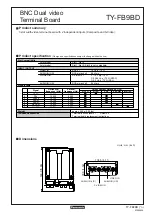
2
2
Compact Photoelectric Sensor
CX-400
SERIES Ver.2
PRECAUTIONS FOR PROPER USE
CX-41
□
CX-42
□
CX-49
□
CX-48
□
Retroreflective type sensor (excluding CX-491□)
Sensitivity adjustment
• Please take care of the following points when detecting
materials having a gloss.
Retroreflective type sensor with polarizing filters (CX-491□)
•
If a shiny object is covered or wrapped with a transparent
film, such as those described below, the retroreflective type
sensor with polarizing filters may not be able to detect it.
In that case, follow the steps given below.
Example of sensing objects
•
Can wrapped by clear film
•
Aluminum sheet covered by plastic film
•
Gold or silver color (specular) label or wrapping paper
Steps
•
Tilt the sensor with respect to the sensing object while fitting.
•
Reduce the sensitivity.
• Increase the distance between the sensor and the
sensing object.
Retroreflective type sensor for transparent object sensing (CX-48□)
• Optimum sensing is possible when the position of the
transparent sensing object is set at the center of the
sensor and the reflector. If the sensing position is set
near the sensor or the reflector, the sensing may be
unstable. In this case, set the sensing position at the
center of the sensor and the reflector.
1
Make L, shown in the
diagram, sufficiently long.
2
Install at an angle of 10 to
30 degrees to the sensing
object.
L
10° to 30°
Make L sufficiently
long
Sensing
object
Reflector
Glossy surface
•
When the sensor detects an uneven plastic receptacle or
glass bottle, the received-light amount may differ with the
sensing position or direction. Adjust the sensitivity after
confirming the stable sensing condition by turning the
sensing object, etc.
• When sensing pipe-shaped transparent sensing object,
set it in a standing, not lying, position as shown in Figure
A. The sensor may fail to detect a lying object as shown
in Figure B.
Sensor
Reflector
Transparent sensing object
Reflector
Sensor
A
Reflector
Sensor
B
Incorrect
Correct
CX-48
□
Step
Sensitivity
adjuster
Description
1
Turn the sensitivity adjuster fully
counterclockwise to the minimum
sensitivity position, MIN.
2
A
In the light received condition, turn the
sensitivity adjuster slowly clockwise and
confirm the point
where the sensor
enters the “Light” state operation.
3
A
B
In the dark condition, turn the sensitivity adjuster
further clockwise until the sensor enters the
“Light” state operation and then bring it back to
confirm point
where the sensor just returns to
the “Dark” state operation.
If the sensor does not enter the “Light”
state operation even when the sensitivity
adjuster is turned fully clockwise, the
position is point .
4
Optimum
position
A
B
The position at the middle of points and
is the optimum sensing position.
Note: Use the flathead screwdriver (purchase separately) to turn the adjuster
slowly. Turning with excessive strength will cause damage to the
adjuster.
Light condition
Dark condition
Thru-beam
type
Receiver
Emitter
Emitter
Sensing object
Receiver
Retroreflective
type
Sensor
Reflector
Sensor
Sensing object
Reflector
Diffuse
reflective
type
Sensor
Sensing object
Sensor
Relation between output and indicators
, : Lights up, : Turns OFF
In case of Light-ON
Sensing
condition
In case of Dark-ON
Stability
indicator
Operation
indicator
Output
Output
Operation
indicator
Stability
indicator
ON
Stable light
receiving
OFF
Unstable light
receiving
OFF
Unstable dark
receiving
ON
Stable dark
receiving









































